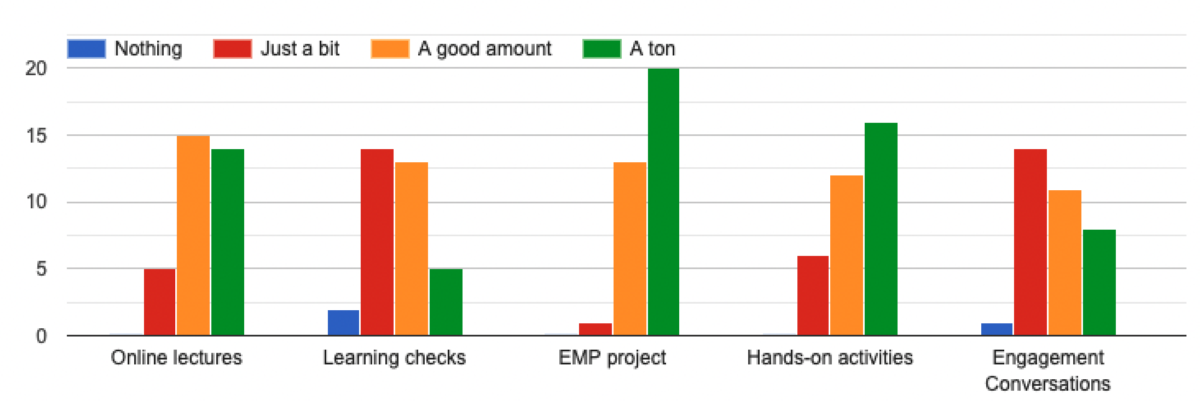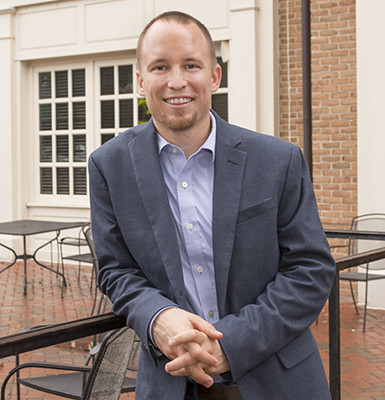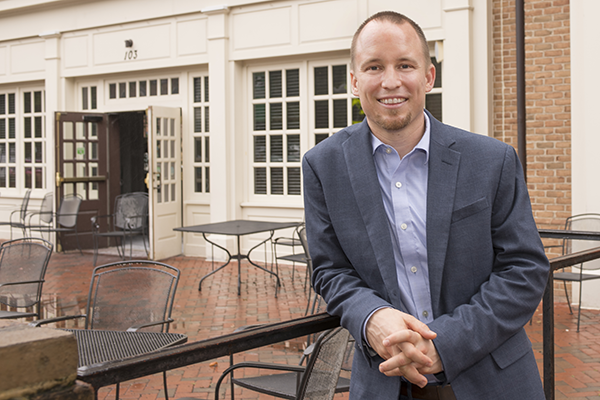Equipping Students to be Entrepreneurial Thinkers: A Conversation with Graham Henshaw
By EMP Staff
How can educators help their students to expand their self-awareness and equip them as entrepreneurial thinkers? Graham Henshaw, EMP Certified Practitioner, Executive Director of the Alan B. Miller Entrepreneurship Center and Clinical Associate Professor at the Raymond A. Mason School of Business, shares the unique ways he uses the Entrepreneurial Mindset Profile® (EMP) with his College of William & Mary students to do just that.
EMP: So nice to talk with you today, Graham. The College of William & Mary’s approach to teaching entrepreneurship is a little different from that of other schools. Can you start off by giving us some background about your focus and how the curriculum has changed over the years?
Henshaw: Our approach is probably a bit broader than most other institutions because we think of entrepreneurship through the lens of entrepreneurial thinking and the set of skills and mindsets that entrepreneurs possess. Our goal is to equip entrepreneurial thinkers and get away from the notion that “entrepreneurship equals startup.” We created a new focus in 2015, did a lot of research to help define what we mean and came up with four skills and four mindsets after synthesizing all of the academic research that was out there. The four skills are Opportunity Discovery, Failing Wisely, Improvisation and Collaboration. As you know, you can teach skills and get better at them. The four mindsets are Openness to Risk, Tolerance for Ambiguity, Grit and Self-Direction.
We wanted to create continuity between the co-curricular activities at the Entrepreneurship Center and the entrepreneurship curriculum so that a student engaging with either one would get the same content. Originally, the curriculum was all about starting a business and how to write a business plan, so there was quite a shift that needed to take place. When we began converting all the courses to this updated approach, we needed something to assess and expose the students to the presence of these things within themselves. And that’s when we discovered the EMP. It’s a great match—not 100%—but perfect for our programs. It really complements a course I teach, Introduction to Innovation and Entrepreneurship, very well because it’s all about entrepreneurial thinking.
EMP: Well, funny that you should mention that course because I noticed that on Rate My Professors one of your students in that class said, “You can learn a lot about yourself and I & E if you take the EMP project seriously.” Tell us more about how you integrate the EMP into that curriculum.
Henshaw: I think the EMP and the associated projects are a core thread throughout the course. I always reiterate with the students that they can get a lot more out of it if they treat it less like an assignment. When they take it more seriously than any other assignment that’s due, there are truly some life-changing insights that can occur.
EMP: So how do you use it? What’s your process?
Henshaw: The students usually take the assessment, and we debrief it during the first week of class. One exercise that we do is like a human histogram where they literally line up according to their top scale on the profile, so it’s very visual. If it has to be in a virtual setting, I’ve done the same thing with Zoom polls. We have a good discussion around that, and I can ask if the exercise matches with what they see on campus as they interact with each other. We also can do it for their lowest scale as well.
EMP: Have you noticed any patterns in the scales in which they tend to score lower?
Henshaw: It seems as if Self-Confidence, Action Orientation, Limited Structure and Risk Acceptance tend to be lower, and Need to Achieve is off the charts high. Many are trying to modulate that scale!
EMP: What do you do after the initial debrief and introductory exercises?
Henshaw: Then I tee up the fact that for the rest of the semester they’ll be on teams with others who are working on the same scales. There’s a tremendous amount of bonding that takes place in these groups over the course of the semester when they do things together, share what’s working and what isn’t and hold each other accountable. When they do this, they’re able to make great strides and show a lot of progress, not only in their post-scores but in their life as well. They see it in their ability to take more risks or use it in a different class, for example. I think this transparency also creates great friendships.
EMP: So you create these groups based on the scales on which they’re working?
Henshaw: Yes. They have an assignment where they have to submit an action plan and pick one scale to work on using the Development Guide as a starting point. They’re asked what they are trying to do and why, and they have to come up with action steps each week, so I know in advance what scales they’re working on, and I put them in groups of three or four. Every few weeks we mix up the teams and shuffle them a bit so the students are always getting new insights from each other.
EMP: In addition to these group discussions, what other activities do these small groups do together throughout the semester?
Henshaw: Every three or four weeks, they have to create a podcast together (3 total over the course of the semester). They have a pre-meeting checklist and a discussion guide to talk about what they want to cover in the podcast, and I give them different prompts including:
- What patterns did you notice about the motivation for people’s goals? Were they externally motivated or internally focused?
- What is the sweet spot for an action step?
- What early successes have you seen, and what contributed to those?
- What challenges have you encountered , and how have you handled those?
- What is the primary takeaway from the first group meeting?
Sometimes it’s not always about lower scores, but they might be addressing something they’re overplaying or maybe it’s a scale that they’re happy where they ended up on the assessment, but they want to use that skill even more. Other groups can engage with the podcasts so that they can learn from each other. They’re responsible for making all the production decisions. Usually one person will host and interview the others, and they will rotate that duty. These groups are often the students’ favorite part of the course, and when asked what aspect of the course resonated the most with them, they have responded as follows:
- Making the podcasts weekly and bonding with my group
- Spending lots of time with my EMP group and talking through our plans
- EMP Plan
- Learning about the different EMP traits and how we can use them outside of the course
- The podcasts by far. Forcing me to distill my thoughts on progress into a few minutes was crucial to my development.
Discussing the different areas on the EMP - I really liked the EMP action plan, the discussion boards and the podcast.
- Time spent in EMP breakout rooms because it really helped me, and the whole group, with our risk acceptance journeys
EMP: The podcasts sound like a great idea! And as you mentioned, they can learn a lot from each other. Do you adjust your curriculum based on where the students score lower?
Henshaw: Each week we’re talking about those pillars of entrepreneurial thinking so there might be a whole week on Risk Acceptance or another week on Limited Structure where I’m doing a lecture on that and a hands-on activity related to it. As the semester unfolds, we’re kind of tackling each one. If it happens to be a scale a particular group is working on, I can see the light bulbs going off with those students as they get new ideas and insights for how to improve.
EMP: What do you think is the primary benefit of using the EMP with students?
Henshaw: I think it gives students a language they can grasp to talk about these concepts. It enables more conversation about something that is a little mysterious. We talk a lot in the beginning about whether entrepreneurs are born or if they can be taught, and students just don’t have the language to have that kind of conversation. The EMP gives us that language, and as a result, it helps to demystify the entrepreneurial mindset. You can see from the following graph how valuable the EMP is to the students’ learning.
How much did you learn from the following aspects of the course (assignments, course content)?

Poll Participants: Introduction to Innovation and Entrepreneurship students at the College of William & Mary
EMP: What aspect of the EMP do you particularly like, or what do you think provides the most value?
Henshaw: I think it’s the action plan concept and the project that we do. I think it’s the most valuable because coming in, students think these are fairly static ideas. For instance, they think if I’m low on Idea Generation, then I’m just not good at coming up with new ideas. It really changes students’ perspectives over the course of the semester.
EMP: Tell me about the final individual assignment the students do with the EMP.
Henshaw: Each student records a short video describing what they learned about themselves from the EMP and how they will use their understanding of their EMP results moving forward. For example, they might use it in a summer internship or in their major. Their comments about their biggest takeaways from the course are enlightening:
- Entrepreneurial skills can be learned and worked on
- I&E isn’t something that is completely innate; through hard work, you can train yourself to be a terrific entrepreneur and innovator.
- How applicable all of the aspects of the EMP are to everyday life
- The EMP mindset is applicable to much more than just I&E or business
- The EMP project and how working on ourselves can really help us improve for the future.
- How I&E can impact your life outside of the business world and entrepreneurial ventures
EMP: Well, Graham, it sounds as if you are really having an impact on these students and broadening their horizons about the entrepreneurial mindset. Thank you so much for your time today, and we wish you all the best in your work with the EMP. Thanks for being such an active Practitioner!

Graham Henshaw is Executive Director of the Alan B. Miller Entrepreneurship Center and Clinical Associate Professor at the Raymond A. Mason School of Business at the College of William & Mary. He can be reached at [email protected].

The Entrepreneurial Mindset Profile® (EMP) [emindsetprofile.com] is an excellent way to get an in-depth view of the entrepreneurial mindset and see how your personality traits and skill sets compare to those of corporate managers and entrepreneurs. Available online, the EMP provides scores on 14 different scales including Risk Acceptance, Passion, Need to Achieve, Future Focus, Idea Generation and Persistence among others. The EMP Feedback Report comes with a debrief video and a comprehensive Development Guide for continuous improvement.
Want to learn more about EMP Certification and how you can use it in your organization? Email us at [email protected] or visit the Certification page of the EMP website to see how you can start using the EMP with your clients and students.


